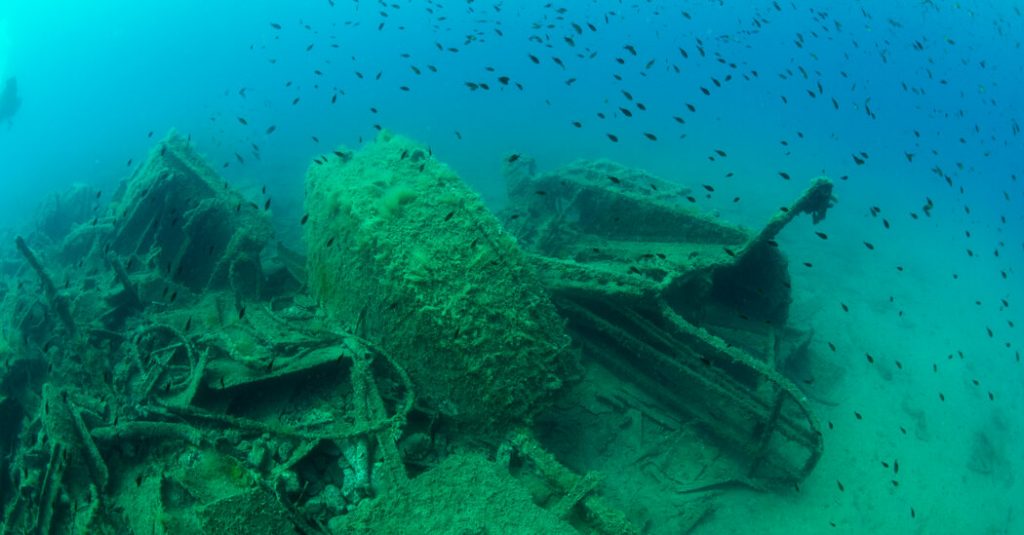
A predawn thunderstorm had cleared the air and brought comfortable temperatures after days of 100 degree heat. As we motored out of Seddulbahir harbor, I could see, on the Asia Minor side of the Dardanelles, the hilltop site of the ruins of ancient Troy — first excavated by Heinrich Schliemann in 1870. Behind us, on the European side, rose the Canakkale Martyrs’ Memorial, a stark, four-columned marble archway dedicated to the 250,000 Ottoman casualties of the Gallipoli Campaign. Much of the peninsula has been turned into a national park, preserved to look as it did a century ago. Scattered among the pristine beaches and rugged, pine-covered hills were cemeteries and memorials commemorating one of the war’s bloodiest campaigns.
Eftelya Dina’s skipper motored a southeasterly course toward the site of the Majestic, just off Cape Helles, keeping his eye on a large screen that displayed sonar images of the sea floor. The entrance to the Dardanelles is littered with British and French vessels, Mr. Kasdemir told me: They include HMS Goliath, a pre-dreadnought battleship, like the Majestic, that an Ottoman torpedo sunk two weeks before the loss of the Majestic and that now lies mostly buried in sediment at a depth of 207 feet. (The pre-dreadnought classification refers to boats built before the 1906 commissioning of HMS Dreadnought, a faster, more heavily armed ship that revolutionized naval warfare.) After 20 minutes, we anchored the two boats. Then I squeezed into my wet suit, strapped on my tank and vest and, along with the three Turkish officials and two diving guides, plunged into the sea.
The water temperature dropped from 74 degrees at the surface to a chilly 60 degrees as we neared the wreck, though my wet suit kept me insulated from the cold. Soon, I found myself hovering over a field of tangled iron and steel — a vast underwater junkyard, or graveyard, spread out for hundreds of yards on the sea floor.
The visibility was surprisingly clear, considering the currents that often rip through the area. As I followed Deniz Tasci through the wreckage, I could make out the curved, intact stern of the ship, the remains of several decks, two stout smokestacks standing upright and one of the boat’s two masts, lying on the port side of the vessel.
Toward the remains of the bow, a long tube angled sharply upward — possibly one of the four 12-inch MK-8 naval guns that pounded Seddulbahir to cover Australian and French ground troops landing at Cape Helles. I spotted a huge cylinder that might have been part of one of the ship’s steam-turbine engines, and strewn in every corner of the wreckage were cigar-shaped torpedoes covered in rust, yet with their explosive warheads still very much in order.
Mr. Kartal had earlier told me that divers had counted “more than 200 torpedoes” scattered around the Majestic alone. There’s almost no chance of these exploding without a powerful jolt, but experienced guides stay close to divers and discourage them from touching anything.
The wreck abounded with sea life, including two-banded sea breams, oval-shaped silver fish adorned with two black parallel stripes running along their heads and tail fins; cuckoo wrasses, with vibrant blue squiggles down their elongated orange bodies; pig-toothed corals, funguslike organisms sprouting inside the wreck’s hollow spaces; and tubular pink and orange sponges clinging to many surfaces. Halfway through the 35-minute dive, one of my companions shone a flashlight into a vaultlike space in the wreckage, where an octopus, now shying away from the unwelcome intrusion, had secreted itself.
You may also like
-
Capturing Stories, Connecting Worlds: The Journey of Cade Chudy and 4th Shore Productions
-
The Multidimensional Universe: A New Theory Unfolds
-
Lights, Camera, Impact: Antoine Gijbels’ Inspiring Videography Journey
-
Striking a Balance: Sophie Annaston’s Journey to Setting Boundaries in the Influencer World
-
Unlocking the Superpower of Critical Thinking: A Conversation with John Chetro Szivos

